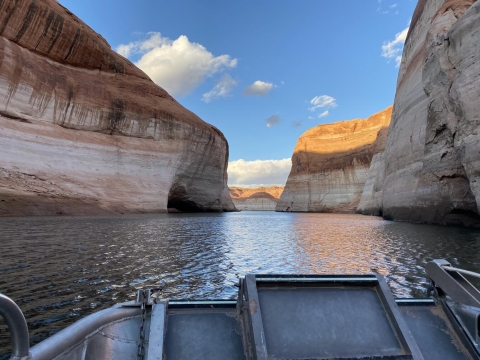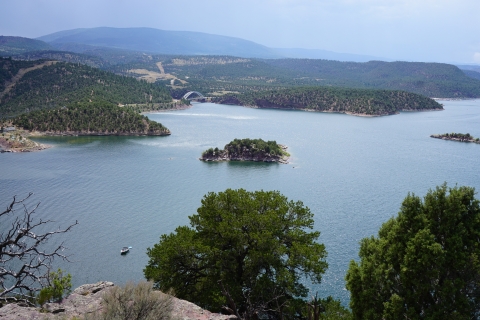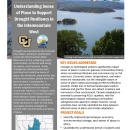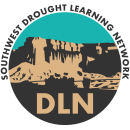Location



















States
Arizona, California, Colorado, Nevada, New Mexico, Utah, WyomingIntroduction
For over 20 years, drought has changed the Colorado River Basin, contributing to aridification across the Intermountain West. The Colorado River serves several gateway communities—small towns that draw residents and visitors with natural amenities like wilderness areas and recreational waterscapes. Drought-related challenges in gateway communities, particularly those near water storage reservoirs, include emotional distress, shrinking water supplies, and impacts on recreation and businesses for activities like fishing.
Drought also affects sense of place—the meanings, beliefs, symbols, values, and emotions that people associate with a particular locality. For example, a fishing guide in a reservoir gateway community (RGC) develops nostalgia for their favorite fishing spot and returns frequently with clients, who begin to love the area. As the water and surrounding landscape change, a closed marina may cost the guide clients and income as well as inflict loss, sadness, and a disconnect from the landscape that they love. Similar challenges demonstrate how physical change can impact sense of place for individuals and communities, demonstrating the relationship between environmental and community health.
While drought’s impact on sense of place can create distress, it may also influence climate adaptations among gateway community members that could increase climate resiliency, such as advocating for water policies. To understand how sense of place influences adaptations and builds stewardship, a research team at the University of Colorado’s Western Water Assessment conducted interviews in three RGCs at Flaming Gorge in Wyoming and Utah, Lake Powell in Arizona and Utah, and Blue Mesa in Colorado. Results may help local managers and partners develop strategies to increase climate resilience and sustainability while maintaining emotional connections to these landscapes. Integrating sustainability, climate adaptation, and sense of place into management and planning strategies can safeguard a resilient future for RGCs while preserving the unique character of each.
Key Issues Addressed
Environmental changes—namely, reduced seasonal water sources, downstream water releases to senior water rights holders, and aridification—significantly impact sense of place in RGCs. Recreation-based economies in these areas rely on reservoirs for boating, birding, fishing, and swimming, activities that bring visitors and generate revenue. As water levels drop, landscape health, environmental resources, and tourism decline, marking drought’s effects on the regions’ commodities.
These shifts further erode the psychological elements of sense of place in RGCs, weakening the emotional bonds between community members and their surroundings. However, the intangible nature of sense of place makes these effects difficult to quantify. In areas that rely on water resources for industry and recreation, partners can measure economic losses in dollars, but capturing the accompanying emotional distress from these difficulties proves to be more challenging. As reservoirs shrink and creeks disappear, the visible loss of beloved landscapes disrupts people’s perceptions, leading to sadness and grief for those who attach memories and experiences to the environment as they once knew it. An understanding of natural heritage that drives stewardship could be lost along with it.
These communities now face the responsibility of climate adaptation in order to preserve their place-based cultural elements. The emotional impacts of environmental change can influence their intentions and willingness to adapt, just as their strong ties to their surroundings inform their level of resilience to climate hazards. Understanding and integrating the link between sense of place and resilience may offer valuable insights for decision-makers when implementing policies or actions that require partners to adapt to changes in water levels or usage.
Project Goals
- Identify the relationships between economic activity, environmental change, and sense of place in gateway communities experiencing aridification and water stress. To accomplish this, researchers used personal interviews to reveal the significance of reservoirs to partners’ environmental connections and perceptions of place.
- Qualitatively understand sense of place and how it is changing in RGCs through firsthand accounts by conducting interviews with partners in case study areas. Partners may later use this qualitative research to form a foundation for creating community-specific strategies to maintain their well-being.
- Determine how sense of place influences community members’ behaviors concerning adaptation, mitigation, environmental protection, and cooperation by comparing across other RGCs and partners groups who experience drought challenges.
Project Highlights
- Interviews Identify Intangible Impacts: Researchers interviewed 26 partners to explore their feelings and experiences concerning drought impacts. Thematic analysis of interview responses revealed that physical changes in special environments caused loss, bewilderment, and grief. Interviews stressed the foundation that sense of place lays for well-being, and the need to preserve place characteristics in decision-making. Using personal, emotional responses to drought offers a closer understanding of how climate hazards impact sense of place.
- Qualitative Methods Connect the Physical to Psychological: Qualitative methods captured vital findings that quantitative approaches miss, particularly the emotional impacts of climate hazards and holistic adaptation strategies for RGCs. For example, participants expressed a deep sense of loss tied to shrinking reservoirs, which not only disrupted livelihoods and water security, but also emotional attachments to the landscape. These insights highlight the value of qualitative research for capturing the intangible connections between people and environment that quantitative studies frequently overlook.
- Partners Act to Preserve Identities: The importance of effective water management and sense of place drives partners to maintain place identities and perceptions. Tying emotional well-being to a commitment to sustainability, they made personal changes like conserving water and seeking renewable energy. They also discussed broader efforts to promote stream and wetland health, and projects aimed at preserving hydrological resources and environmental conditions. Their commitment to action led researchers to consider the benefits of establishing communities of practice (CoPs).
- Communities Drive Solutions for Sustainability: Partners trust local leaders, demonstrating communal social unity, but mistrust state and federal governments due to perceptions of poor transparency and decision-making, creating dynamics that hinder progress for adaptation. Establishing CoPs in RGCs can strengthen collaboration between higher- and lower-level authorities, amplifying community voices and fostering inclusive solutions. This exciting prospect inspired researchers to propose a second engagement project, using research findings to support adaptation and sense of place through CoPs.
Lessons Learned
Partners in RGCs hold strong senses of place, invested in beautiful landscapes, economic opportunities, and close-knit communities, but climate hazards, migration, and other external pressures threaten these qualities. While partners adopted measures like conserving water and recycling, they urged broader collaboration from decision-makers and communities across the West who face similar challenges. Increased migration and visitation further strain resources and cultural elements essential to individual and collective security. Although reliant on tourism revenue, partners lamented the strains imposed by newcomers. Decision-makers must consider these complex dynamics by balancing economic stability with maintaining community lifestyles. Examining each RGC’s unique challenges may open opportunities for collaboration across partner groups or other communities.
Partners’ strong bonds to their landscapes and communities drive their commitment to protecting personal interests. Service and recreation businesses, dependent on reservoirs for prosperity, suffer from declining water levels, which further alters sense of place. Recreational users visit different spots to minimize stress on wilderness areas. Despite longing for routine activities and locations, partners in RGCs demonstrated strong desires to adapt to changes because of their deep personal investments in preserving local culture and ecosystem services.
Given the contentious nature of Western water issues, researchers prioritized involving all partner groups. They interviewed residents, recreationists, business owners, workers, local leaders, educators, Earth and social scientists, and environmental organizations. Researchers contacted several agricultural partners but few responded, leaving insufficient rancher and farmer input, despite their significant water use, influence, and rights conflicts. Researchers chose not to solicit Indigenous partners, recognizing that without established reciprocal relationships, doing so would risk perpetuating extractive research practices. Researchers acknowledge this major exclusion and are working to expand networks in order to thoughtfully and respectfully incorporate Indigenous voices in future studies. Moving forward, building a community of practice around sense of place could foster knowledge sharing and collective action across all partner groups.
Next Steps
- University of Colorado researchers are drafting a proposal to partner with RGCs, Western Water Assessment, and Utah State University’s Gateway and Natural Amenity Region (GNAR) Initiative in order to assist RGCs in establishing communities of practice (CoPs). With CoPs, partners can collaborate and share knowledge on reservoirs, local politics, water management, restoring stream health, and environmental stewardship. CoPs around Colorado River communities will focus on sustainable adaptation and maintaining sense of place, crafting strategies for drought and water management. Sharing expertise and experiences can improve partners’ understanding of key issues and promote cooperation across the Colorado River Basin, addressing barriers that have hindered a collective approach to successful drought management (Gerlak et al., 2021).
- This CoP proposal will actively involve Indigenous communities in decision-making related to climate challenges and water management. Frameworks for co-production written by Indigenous academics will help guide an equitable and inclusive process. Supporting a decolonial approach to co-production and water management requires prioritizing several considerations. These include Indigenous approaches to conflict transformation, uplifting culturally pertinent practices, and respecting traditional ecological knowledge. Building trust with follow-through, developing relationships, compensating participants for their time, co-creating pathways for Indigenous leadership, and encouraging critical reflection from non-Indigenous partner groups will focus on the commitment to Tribal sovereignty and shifting away from practices that have perpetuated a long history of colonial violence.
- Researchers intend to further examine how sense of place influences adaptations to climate hazards in CoPs and potentially other gateway communities in the Intermountain West. By comparing responses from study participants across other RGCs, partners may identify different adaptation strategies, opportunities for collaboration, or solutions that work in diverse communities.
Funding Partners
- University of Colorado Boulder
- Western Water Assessment
- National Oceanic and Atmospheric Administration (NOAA) Climate Adaptation Partnerships (CAP)
Sources Referenced
- Understanding thematic analysis
- Communities of practice: Sustained learning partnerships
- Utah State University: Gateway and Natural Amenity Region (GNAR) Initiative
- Colorado Division of Water Resources: Water rights
- Gerlak, A. K., Karambelkar, S., & Ferguson, D. B. (2021). Knowledge governance and learning: Examining challenges and opportunities in the Colorado River basin. Environmental Science and Policy, 215, 219-230.
- Yua, E., Raymond-Yakoubian, J., Daniel, R. A., & Behe, C. (2023). A framework for co-production in the context of arctic research. Ecology & Society, 27(1): 34.
Contact
Karen Bailey, University of Colorado Boulder, karen.bailey@colorado.edu
CART Lead Authors
- Shadia Nagati, University of Colorado Boulder, shadia.nagati@colorado.edu
- Dustin O’Brien, University of Colorado Boulder, dustinobrien32@gmail.com
Suggested Citation
Nagati, S., O’Brien, D., & Bailey, K. (2024). “Understanding Sense of Place to Support Drought Resiliency in the Intermountain West.” CART. Retrieved from https://www.fws.gov/project/sense-place-supports-drought-resiliency
The DLN is a peer-to-peer knowledge exchange between climate service providers and resource managers, created to gather and share lessons learned from drought events to prepare for future events. The DLN partners with CART to develop Case Studies, with funding from the National Drought Mitigation Center for interns and coordination support from the USDA Southwest Climate Hub.






